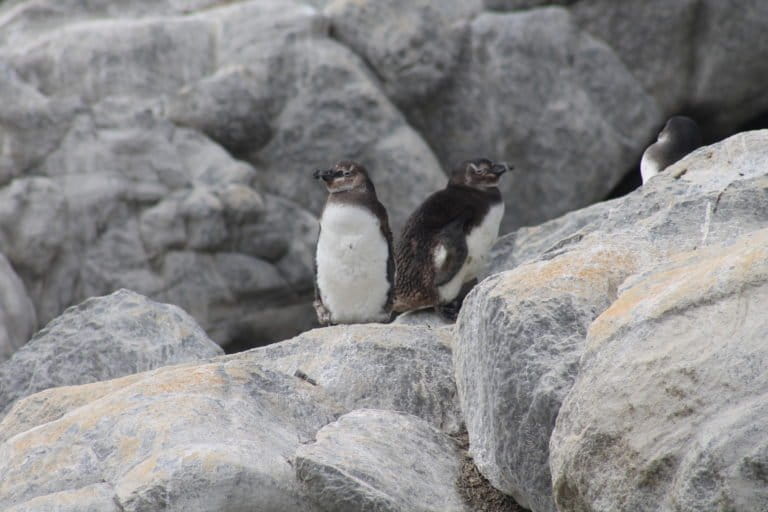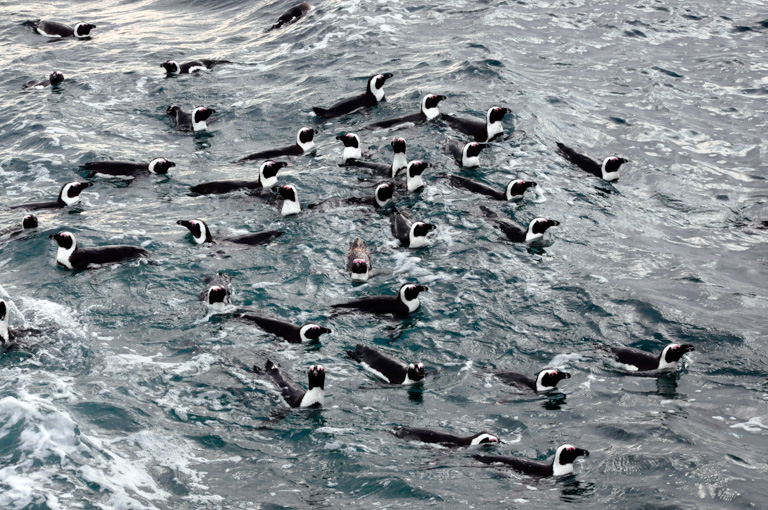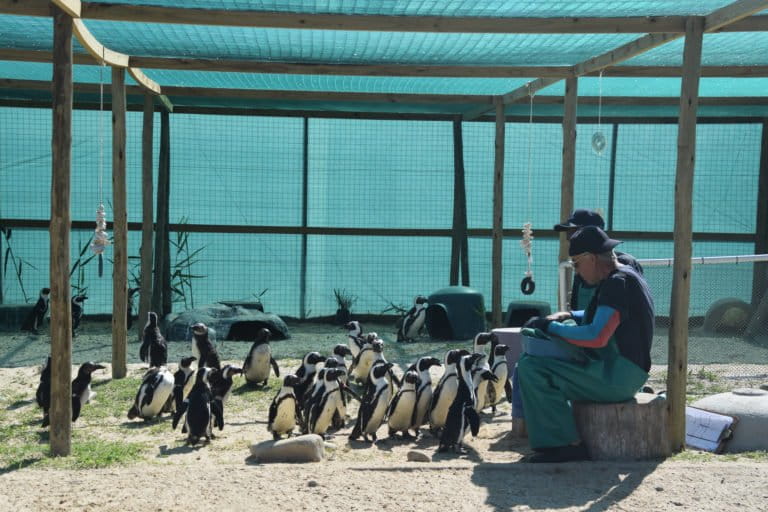- Two African penguin chicks have hatched at a nature reserve in South Africa where conservationists have been working for years to entice the endangered birds to breed.
- The colony was abandoned more than 10 years ago after a caracal killed a number of penguins.
- The recent hatching comes at a time when survival prospects for Africa’s only resident penguin species look grim, due mainly to declining food stocks.
- But encouraging new colonies at sites close to abundant food sources could help to bring the species back from the brink.
Two African penguin chicks have emerged from their nest beneath a boulder at a site in South Africa where conservationists have used lifelike decoy penguins and broadcast penguin calls to entice adult penguins to breed.
Christina Hagen, the Pamela Isdell Fellow of Penguin Conservation at BirdLife South Africa, who leads the project, was on one of her regular trips last month to monitor the site in De Hoop Nature Reserve, in South Africa’s Western Cape province, when she spotted them.
“I was watching the penguins out on the rocks and suddenly I could see this fluffy little shape near one of the adults,” she told Mongabay.
“When I looked more closely I realized it was a chick. As I watched, another joined them from underneath the rock where they were nesting.”

Work began in earnest four years ago as part of a program to protect the endangered African penguin (Spheniscus demersus) along South Africa’s coastline.
The decline of Africa’s only resident penguin species began in the 1800s. People collected their eggs to eat and their guano, which had built up over centuries, to export as fertilizer. That left the birds with nowhere to dig burrows to shield themselves, their eggs and their chicks from heat and predators.
To make things worse, over the past 30 years or so, climate change and commercial fishing have depleted stocks of anchovies and sardines, the penguin’s main prey, or caused shoals to migrate elsewhere. Low survival rates of both adult and juvenile penguins at key breeding colonies on Dassen and Robben islands are linked to the scarcity of sardines off South Africa’s western coast, researchers say.
The total population of African penguins has dropped by nearly 65% since 1989. There are now estimated to be fewer than 10,000 breeding pairs in South Africa, the lowest ever, and around 5,000 pairs in Namibia, Hagen said.
Given African penguins’ preference for islands, coaxing them to nest on land at sites like De Hoop is a long and difficult business. But Hagen and colleagues from CapeNature and the Southern African Foundation for the Conservation of Coastal Birds (SANCCOB) settled on the nature reserve precisely because of the rich fish stocks in the waters of this marine protected area.
Penguins fitted with GPS tracking devices had been recorded swimming to De Hoop all the way from Dassen Island, 400 kilometers (250 miles) away. They needed to fatten up ahead of their post-breeding molt — a time when they’re confined to the land and replace all their feathers and lose half their body mass because they can’t go to sea to feed.
“That gave us confidence that there was fish abundance in that area; that they were making that long trek,” Hagen said.

But breeding on the mainland comes with hazards. The penguins are highly vulnerable to lethal attacks: caracals, dogs, cats, mongooses and even bees have been known to kill penguins.
De Hoop did host 18 breeding pairs and up to 100 roosting penguins from 2003-2008. But they abandoned the area after a predator, thought to be a caracal (Felis caracal), killed a number of them.
“What often happens with cat predators is that they do spree killing,” Hagen said. “Because the penguins are so naïve to predators they just stand there and don’t know what to do. That sends the predator into a frenzy.”
Four years ago, long before there was any hint that penguins wanted to return, Hagen and her colleagues sealed off the De Hoop breeding site, which is located on a rocky headland. They raised a 2.4-meter-high (7.8-foot) fence with electrified strands at the top and bottom.
The fence is monitored 24 hours a day, and Hagen is able to keep a constant eye on possible encroachments via the app on her phone. There was one, in 2019, by a leopard (Panthera pardus). But that was before the penguins’ return, Hagen said, and the incident allowed her to identify a weak spot in the fence. That’s now been reinforced.
“I’m pretty confident in the fence’s ability to keep out predators,” she said.
A key tool in restoring De Hoop as a breeding site has been the release of young penguins. More than 140 have been released there since 2021. These are birds that were abandoned as eggs or chicks and hand-reared by SANCCOB at a specialized unit it runs in Cape Town.

Young penguins return to the place where they were raised. The hope is that the released penguins will identify De Hoop as their home colony and return to it as adults in three to four years’ time.
Which is why the sight of penguin chicks in late October came as such a surprise to Hagen. “I was speechless,” she said. “It happened faster than I expected.”
A few months earlier, she and colleagues had been excited to discover three adult penguins at the site. There was, however, no evidence they were preparing to nest.
Hagen credits the recent upgrading of a speaker that broadcasts penguin calls almost continually with the help of a solar-powered minicomputer and amplifier. Louder broadcasts, she thinks, may have finally got the attention of penguins looking for a place to settle. The lifelike cement decoy penguins dotted around the headland possibly also played a part, making it look as if it was already occupied.
Cape cormorants (Phalacrocorax capensis) and swift terns (Sterna bergii) had also recently started roosting in the area, which “probably gave them the sign that it was safe to move in,” she said.
The breeding of penguins at De Hoop is great news, says Lorien Pichegru, acting director of the Coastal and Marine Research Institute at Nelson Mandela University, who is not involved with the De Hoop project.
“It may help increase the resilience of penguins in the face of changing food availability in their traditional grounds,” she told Mongabay.
Penguin colonies do, however, grow slowly. Pichegru pointed to sites at Stony Point near the coastal town of Betty’s Bay, and Boulders Beach, in Simon’s Town, which were also founded by one or two breeding pairs in the early 1980s. The two sites now host around 1,600 and 1,000 breeding pairs respectively.
“It would require at least 10 years or more to have a colony of more than a few hundred pairs [at De Hoop],” she said.
“Trying to move penguins to other new colonies away from their islands is not a long-term solution. Preserving their food stocks is,” Pichegru said. “Urgent actions are required to increase food availability to penguins so the population as a whole can survive in the wild and not become functionally extinct.”
A population becomes functionally extinct when it lacks the genetic diversity to survive long into the future. A 2018 study co-authored by Pichegru and more than a dozen other scientists predicted that without prompt action to protect food stocks, African penguins could become functionally extinct — with fewer than 50 pairs — along South Africa’s west coast by 2035.
“It is a scary statistic, but it doesn’t mean that penguins will be entirely gone,” Hagen said. “We still have time to turn that around, and there are a lot of people working very hard to try and make sure that happens.”
Luring penguins to breed in places with rich food stocks isn’t the only way humans are intervening. There’s ongoing research being done to perfect nesting boxes that replicate the old guano burrows to keep penguins cool and safe in a world whose climate is becoming hotter and less predictable.
Hagen acknowledged that while a single breeding pair of African penguins at De Hoop won’t do much to contribute to the conservation of the species, it’s nevertheless an important measure of success.
The next indicator, she said, will be an increasing number of breeding pairs each year, as happened at Stony Point and Boulders Beach over the past 40 years.
“I’m hoping the success we’ve seen at De Hoop will revitalize the conservationists working on African penguins, to show there is hope — that we can try and save this species.”
Citations:
Sherley, R. B., Barham, B. J., Barham, P. J., Campbell, K. J., Crawford, R. J., Grigg, J., … Votier, S. C. (2018). Bayesian inference reveals positive but subtle effects of experimental fishery closures on marine predator demographics. Proceedings of the Royal Society B: Biological Sciences, 285(1871), 20172443. doi:10.1098/rspb.2017.2443
Sherley, R. B., Ludynia, K., Dyer, B. M., Lamont, T., Makhado, A. B., Roux, J. P., … Votier, S. C. (2017). Metapopulation tracking juvenile penguins reveals an ecosystem-wide ecological trap. Current Biology, 27(4), 563-568. doi:10.1016/j.cub.2016.12.054
Sherley, R. B., Crawford, R. J., de Blocq, A. D., Dyer, B. M., Geldenhuys, D., Hagen, C., … Winker, H. (2020). The conservation status and population decline of the African penguin deconstructed in space and time. Ecology and evolution, 10(15), 8506-8516. doi:10.1002/ece3.6554
FEEDBACK: Use this form to send a message to the author of this post. If you want to post a public comment, you can do that at the bottom of the page.
